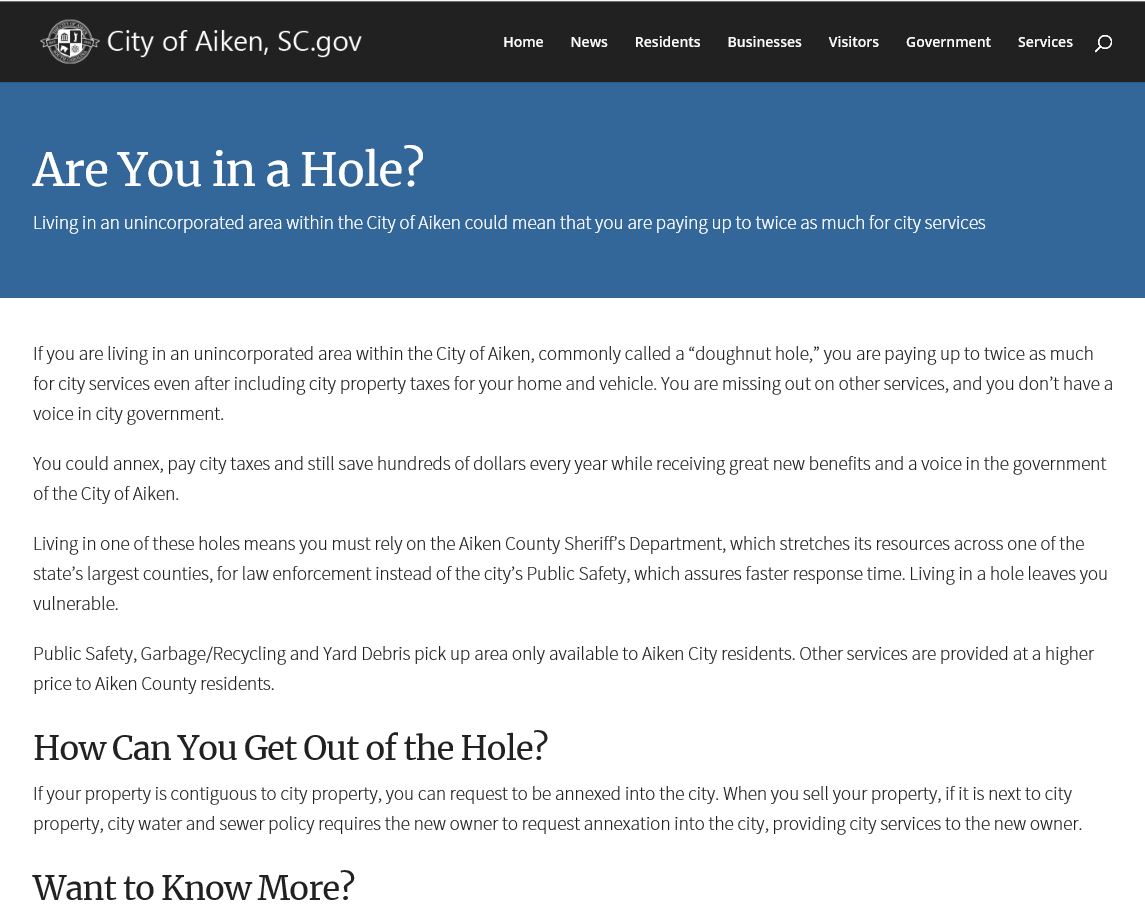During last year's Regional Advocacy Meetings, local government officials expressed their support for changing South Carolina's laws to allow cities and towns to annex enclaves through an ordinance passed by city council in addition to the current methods.

The City of Aiken offers a webpage for residents living in an unincorporated area of the city, known as a doughnut hole, which explains how to request annexation.
Local officials reported that enclaves — unincorporated areas completely surrounded by a city — disrupt the efficient delivery of services and create confusion among residents. Residents and businesses located in enclaves are completely surrounded by a municipality and often face uncertain public safety response times and inefficient service delivery.
In addition to raising questions over maintenance or zoning issues, enclaves also provide an element of confusion over essential government services such as water, sewer, garbage, police and fire protection.
While residents within enclaves miss out on reliable services, they do, however, enjoy the enhanced quality of life provided by some municipal services, such as parks, infrastructure and planning. This raises a question of equity. It's the businesses and residents within the incorporated areas that are paying for enclave residents and businesses to enjoy these municipal services.
As a result, the Municipal Association of SC will work to update the state's annexation laws in the 2018 session of the S.C. General Assembly to help municipalities improve service delivery, protect the public, expand economic development opportunities and meet the demands of growth across the state. Cities and towns work to deliver services to their residents as efficiently as possible and to ensure everyone using those services helps to pay for them.
"City and county garbage trucks driving past one another to serve residents on the same street is an inefficient way to pick up trash," said Scott Slatton, legislative and public policy advocate for the Association.
"And residents living in enclaves adjacent to cities often take advantage of city services like police and fire, but they don't help pay for them, which creates an unfair burden on taxpayers who live in the city limits."
The City of Aiken is actively promoting annexation of its enclaves to improve efficiency by accurately and transparently demonstrating the costs and benefits of annexation.
The City of Camden recently annexed a dilapidated shopping center in an enclave that had become a haven for problems. Underscoring the difficulty presented by the state's current annexation laws, it took years, and special legislation that was eventually vetoed, to accomplish the annexation. However, the city will now have the authority to abate existing problems, work with the shopping center's owners to help rehabilitate the property and make it an asset for the surrounding community.
H3158, the Local Government Efficiency Act
At least one proposal pending before the S.C. General Assembly seeks to address the challenges enclaves pose to cities and towns. The bill, H3158, prefiled in December, specifies that a city council may annex enclaves by ordinance provided that
- The enclave is 25 acres or less.
- The enclave was surrounded by the city for five years or more.
- The city notifies all property owners of its intent to annex.
- City council conducts a public hearing.
- The city states the services that will be provided, the taxes and fees required for those services, and when the services will be provided.
Last December, the bill's sponsor, Rep. Mandy Powers Norrell (D – York), met with the Association of SC Mayors to outline her approach to getting the bill through the legislative process in the 2018 session. She stressed the importance of identifying a variety of sponsors from both sides of the aisle and from cities of all sizes. She also encouraged the mayors to share with their delegation members their local stories about issues that have arisen because of enclaves.
Steps to annexation in current law
100 percent petition method
- City receives and accepts petition for annexation from 100 percent of the property owners who own 100 percent of the assessed value of property in the area requesting annexation.
- City council considers ordinance to annex property.
- If ordinance passes, the annexation is complete, and city notifies county and state agencies of annexation.
75 percent petition method
- City receives and accepts petition for annexation from 75 percent of the property owners who own at least 75 percent of the assessed value of property in the area requesting annexation.
- City conducts mandatory cost/benefit feasibility study for area proposed for annexation.
- City conducts public hearing.
- City council considers ordinance to annex property.
- If ordinance passes, the annexation is complete, and the city notifies county and state agencies of annexation.
25 percent petition election method
- City receives petition from 25 percent of qualified electors within area proposed for annexation.
- City council accepts petition and certifies petition to county election commission.
- County election commission conducts special election where all qualified electors in area proposed for annexation may vote to annex or not.
- If an area votes "yes" on the question of whether to be annexed, current residents of the city then have a chance to reject the annexation if 5 percent of them file a petition with the council.
- If 5 percent file a petition, then the current city residents vote on whether or not to accept the annexation. But if 5 percent of city residents do not file a petition within the time prescribed by law, then council can accept the annexation.
- If a majority of the votes cast by city electors is in favor of the annexation, city council gives final reading to the ordinance to annex the property. Otherwise, council tables the proposed annexation ordinance.
- If ordinance passes, the annexation is complete, and city notifies county and state agencies of annexation.
